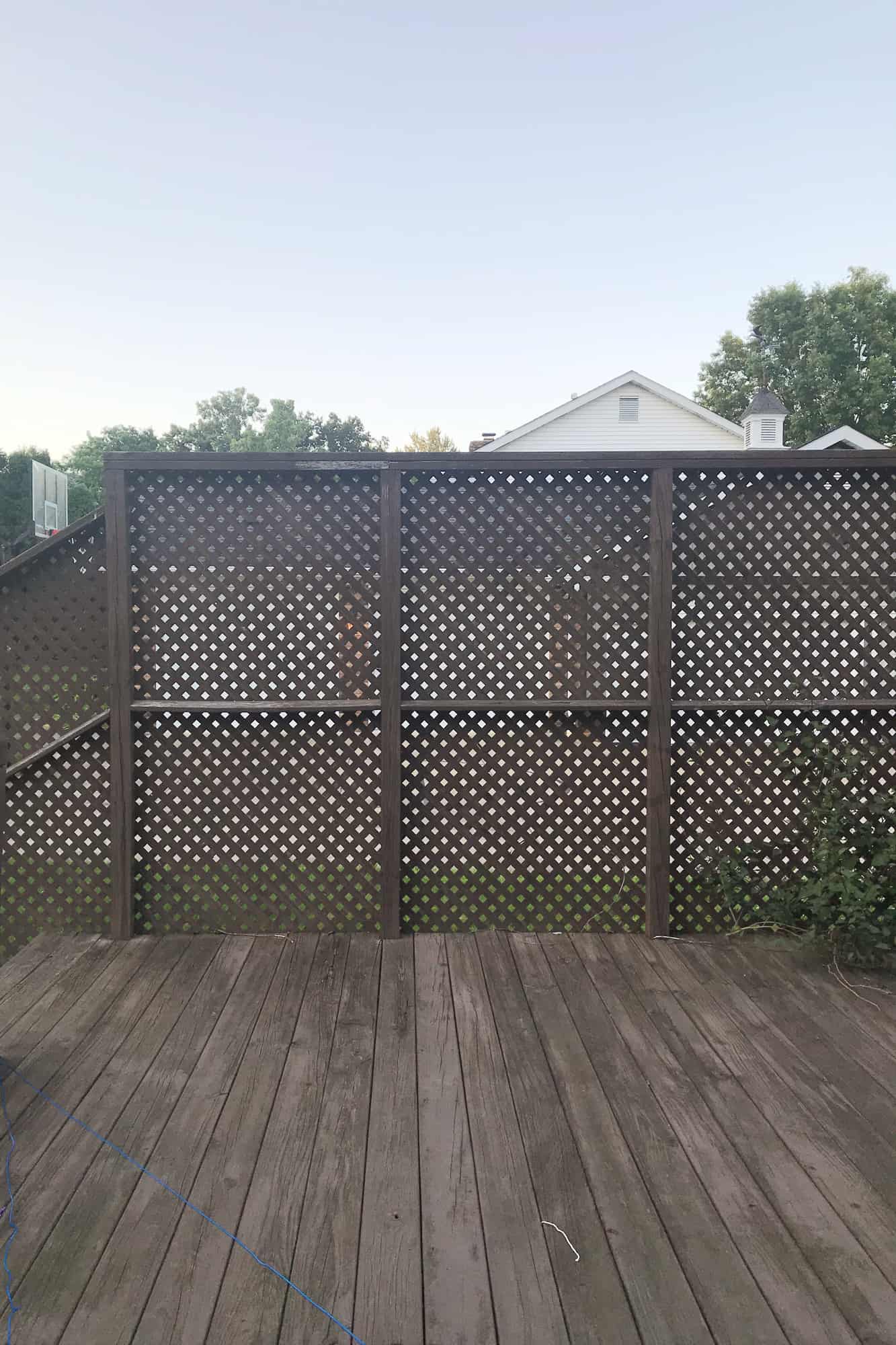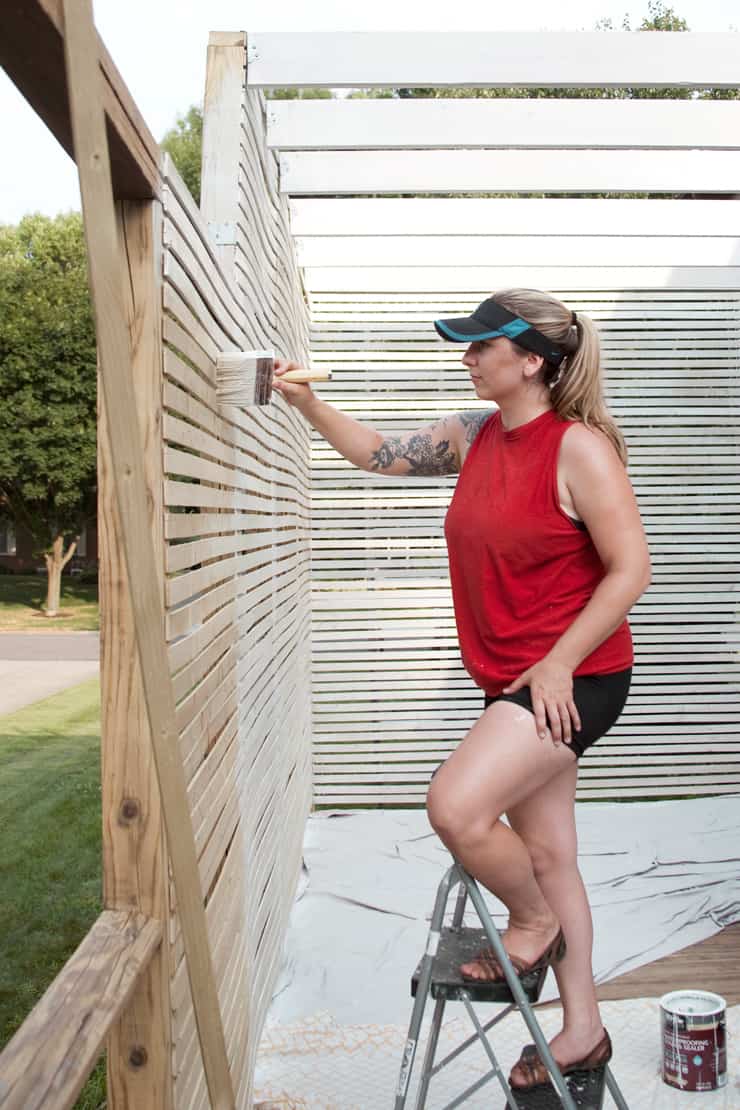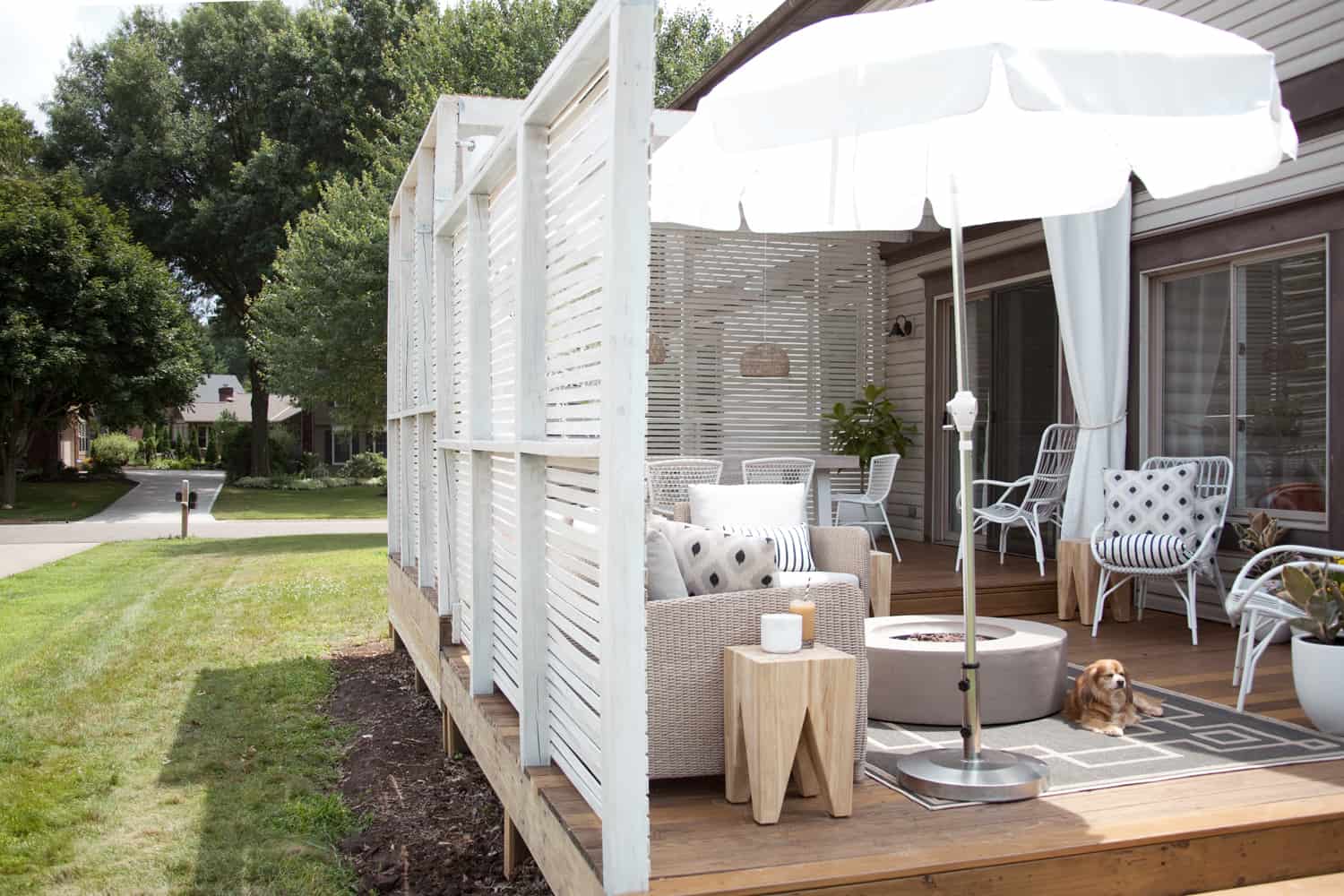 I spent years pining for a slat wood privacy fence to call my own. We never got around to putting one up at our old house, but this time around, it was a top priority for me! The white slats create a clean yet textural backdrop for our outdoor seating area, and our neighbor’s garage is no longer the main view when sitting on our patio. We just love the new slat wood patio backdrop, and I’m so glad we put the effort in to installing one at our new home!
I spent years pining for a slat wood privacy fence to call my own. We never got around to putting one up at our old house, but this time around, it was a top priority for me! The white slats create a clean yet textural backdrop for our outdoor seating area, and our neighbor’s garage is no longer the main view when sitting on our patio. We just love the new slat wood patio backdrop, and I’m so glad we put the effort in to installing one at our new home!
When we moved in, there was a privacy fence already here. It wasn’t the most awful thing, but it definitely needed some love. I wasn’t a fan of the original privacy fence’s traditional trellis style, and the darkness of the entire patio was really bringing me down. Since the deck floor needed a lot of TLC, we figured this would be a great opportunity to put up the slat wood fence of my dreams! The only problem was money.
 I had envisioned using 1×4 treated wood slats, or maybe even cedar, to form a beautiful and substantial privacy fence around our deck. But when it came time to price the materials, I was astounded at how much it would cost! We had around 380 square feet to fence, and it turns out treated lumber (and especially cedar) isn’t exactly cheap. Everyone loves having a big deck until it’s time to roll up their sleeves and work on it!
I had envisioned using 1×4 treated wood slats, or maybe even cedar, to form a beautiful and substantial privacy fence around our deck. But when it came time to price the materials, I was astounded at how much it would cost! We had around 380 square feet to fence, and it turns out treated lumber (and especially cedar) isn’t exactly cheap. Everyone loves having a big deck until it’s time to roll up their sleeves and work on it!
I was still determined to have the slat wood privacy fence of my dreams, but I needed to find a workaround to keep it affordable. I would have to keep the fence posts that were already in place (not a huge deal), and I would have to find a less expensive material for the slats. After using lattice strips in our study makeover, I knew lattice strips are very affordable. And though they’re pretty thin at only 1/4″ thick, lattice would be substantial enough for a privacy fence around our deck. So I checked around and decided to buy a ton of pressure-treated lattice slats from Home Depot for my project.
Budget constraints met, problem solved, right? Right …? You know there’s always more to the story. Nothing is ever easy when doing home reno projects on a budget!
 Sourcing Lattice Strips
Sourcing Lattice Strips
I filled my Home Depot online shopping cart with 360 lattice strips, and selected the “deliver to home” shipping option. I think it said something like $200 to ship all of that wood to my house, so after a shocking blink at my computer screen, I began devising plan B. Okay, I could pick them up in store. But my local Home Depot store only had 58 slats in stock. Alright. It’s cool. It’s cool. We can drive to five different stores to get the amount we need. No big deal. (Okay, moderately big deal.)
After I had all 360 slats in my garage, I unwrapped them and sorted through each piece. I was disappointed, but not shocked, to see that about 1/3 of the slats (really more like 1/2 if I was being really picky) were so warped they were unusable. I made three piles: good enough, maybe good enough, and definitely nowhere near good enough.
In the end, we were able to replace the junky lattice strips with ones that we made ourselves, thanks to my dad’s amazing table saw and willingness to help! If we didn’t have that option, I would’ve done the legwork to pick up more slats and crossed my fingers that there would be enough to use. (I am returning the ones that were too warped to use, so nothing lost besides time and fuel.)
Making Your Own Lattice Strips
Making your own lattice strips is more cost effective, and produces a better quality lattice strip than buying them in bulk at a major hardware store or even a reputable lumber yard. But obviously, making your own strips takes some time to do.
To make our own lattice strips, we used treated 2×6 lumber and cut them on the table saw with the fence set at 1/4″ thickness. Each 2×6 board rendered 15 strips and took about 30 minutes to make on a large, stationary table saw.
Before cutting the 2x6s into strips, we let the wood dry out in the sun for a few days. When drying treated lumber from the stores, it’s okay if the wood is subjected to rain. What you’re really looking to do is to allow the moisture that has been trapped (for potentially months) an opportunity to escape from the wood fibers. Lumber is stored in huge flats, often outdoors in rainy conditions. The boards that are positioned in the middle of the flats end up water logged for quite a while, without a chance to ever dry out.
The reason you need to dry the wood before cutting into strips is two-fold. First, as previously water-logged boards dry out, they may warp, and you’ll know if it’s not a good board to use. If the board warps, take it back to the store. Secondly, if you cut the strips when the wood still has residual moisture in its fibers, the slats you cut will bow and warp as they dry, rendering them useless. We had experience with everything I just described. No need to rush things! Doing it right will save you time and money in the long run. “Haste makes waste” has never been more true.
Another benefit to making your own slats, besides quality control, is that you are not limited to the 8′ lengths that are available at the store or lumber yard. We were able to make 14′ long strips for some of the sections, saving us installation time and eliminating seams in certain places.
 Building the Slat Wood Fence
Building the Slat Wood Fence
Step One: Put your fence posts into place. Unfortunately for you, but fortunately for me, I already had fence posts in place. If you need to make your own, you can choose to secure them in the ground with concrete or with mounting directly to your deck with Strong Tie 4×4 bases.
Securing Posts Into the Ground
At our old home, we had to dig the holes for our fence posts, so I do have a bit of experience to share about this, though no photos. We used a post hole digger to put evenly spaced holes (4′ apart in this case) in the ground. That space was then filled with concrete. We chose not to put our 4×4 posts directly into the concrete, because the wood in the concrete will eventually rot, making it necessary to remove the concrete and begin again when replacing the rotted wood. Instead, we used a Strong Tie base that we screwed into the concrete to hold the 4×4 post.
Securing Posts Onto the Deck
Our fence posts at our current home are simply mounted onto the deck. You can use the same Strong Tie base for this, but screw directly onto the deck. It will not be the most sturdy unless you are forming an L-shaped fence. Just one straight row of tall 4x4s will not be as sturdy, especially the taller you make it. Our fence is an L (as seen above left), and we secured one length of it to our house, which made the entire fence pretty sturdy. (Especially sturdy after building a pergola, but more on that in another post!) (Also, how many times did I just say sturdy? Whew!)
Step Two: Add a topper board to your 4×4 posts. Using a topper board will help keep the post secure and keep them level. As you nail or screw the top board into place, make sure the posts are level and equally spaced at their top and at their base. The previous fence had two stacked 2x4s on the top, but they were rotted and so we had to replace them. We chose to replace the double 2x4s with just single 2x4s.
Step Three: Add nailer boards to any inside corners you may have. If you don’t add nailer boards at an inside corner, then one of your rows of lattice strips will have nowhere to nail into, because your post will be covered by the first section of slats you nail in. We used a treated 2×2 for a nailer board, ripped in half to preserve materials (as seen above right). We probably should have left it at its full thickness, as it was almost too thin to work for us!
 Step Four: Apply construction adhesive where you will be attaching the lattice strips.
Step Four: Apply construction adhesive where you will be attaching the lattice strips.
Why use adhesive when nails should work perfectly fine? Good question! Treated lumber is called “treated” because it has been treated with harsh and powerful chemicals that help it last against harsh weather conditions. But those chemicals will also eat away at any metal that hasn’t been specifically coated for use with treated lumber. Which is also why pregnant women should not handle treated lumber. We didn’t have special coated nails, so we wanted to add adhesive for when the nails begin to fail, years in the future.
Step Five: Use a spacer to evenly place your lattice strips. I used a 1/2″ square dowel for this. To attach the strips, we used an air nailer. It’s quick and easy to air-nail if you have the tools, but a simple hammer and nails will do the trick too! (And develop those forearm muscles!)
 Step Six: Paint your fence! (I was thinking of Mr. Miyagi and Danielson the entire time I painted this fence, especially when I felt like giving up!) I chose to use Behr’s premium semi-transparent pure white deck stain from Home Depot. Two coats gave me the perfect coverage, with still showing some of the wood grain.
Step Six: Paint your fence! (I was thinking of Mr. Miyagi and Danielson the entire time I painted this fence, especially when I felt like giving up!) I chose to use Behr’s premium semi-transparent pure white deck stain from Home Depot. Two coats gave me the perfect coverage, with still showing some of the wood grain.
I do have a couple of tips for painting a slat wood fence. Looking back, we definitely should have painted the posts before adding the lattice strips, because it was a bit tricky to get the brush onto the fence posts between each strip without paint oozing onto the backside of the fence in the process.
Speaking of oozing paint, another good tip is to paint the fence with a helper. One person should paint the inside while the other person works on the back side. This will prevent unnoticed drips from drying and making unsightly drip marks.
 Project Timeline
Project Timeline
Let me just say this project was pretty tedious. It definitely wouldn’t have been as soul-sucking if we had just made one 16′ privacy fence. But three? Yeah, we were rejoicing when the job was over.
We tackled this entire fencing project on weekday evenings. Every day after dinner, we would spend three hours working on nailing up a section of slats. This is definitely a two-person job, and it does go quicker once you get into a rhythm. Doing everything you see here (below) took 6 evenings of work. We preferred breaking it up like that rather than working on it all day on a Saturday, because of how tedious it became after a while of working. Not so bad when you break it up. But from sun up to sun down? Soul-sucking. For sure.
As far as painting goes, it took us several hours to do one coat of paint, but only a couple of hours to do coat two. It is so true that the second coat is much easier and faster to apply! Just always be on the lookout for drips.

 I suppose the big question is, was all that work worth it? The answer is a quick and easy YES. Of course! I’m so happy to finally have my dream slat wood privacy fence. It really makes our deck feel like an extension of our home.
I suppose the big question is, was all that work worth it? The answer is a quick and easy YES. Of course! I’m so happy to finally have my dream slat wood privacy fence. It really makes our deck feel like an extension of our home.
All of the outdoor furniture we used on our deck (besides the firepit) was provided by Article, and they’re really the most amazing pieces! I’m a big fan of wicker, but obviously it just doesn’t hold up so well outside. I love how natural Article’s synthetic wicker looks, but the best part is I know they’ll stand the test of time. We’ve already spent lots of time snuggling on our new Calo sofa and chair. It’ll be a bummer to head back inside come wintertime!
I’m looking forward to sharing more of the deck project with you soon. But for now, I need to sign off and crank up the firepit, baby! It’s s’mores time! – Mandi




22 Comments
Wish I had a little garden or patio to build this! So nice! 🙂
Charmaine Ng | Architecture & Lifestyle Blog
http://charmainenyw.com
OBSESSED with your fire pit. Is it also from Article? I couldn’t find it on their site!
Agree , this fire pit is gorgeous . Would you share the link it is exactly what I’m looking for on my new patio.
It’s not. I purchased it from Wayfair. Here’s a link: http://bit.ly/2lA5hQ2
I love it!!!! You did such a great job. I love that you painted in shoes, my redneck self would have done it barefoot!
Those are my working shoes! haha! They’re actually Crocks— about 6 years old and still going strong. I couldn’t handle working barefoot considering I was on my feet working for several hours each day! At the end of each day my feet were kiiiiilling me.
Mandi, I love your brilliant home reno mind! This project turned out beautifully and I love that you found an affordable solution. Those horizontal lines are definitely more modern and calming than the diagonal trellis you had before, and the way you’ve decorated that space is absolutely gorgeous.
Really great how to, this is so useful! I’ve always wanted a way to add privacy to my place without taking up too much space or costing too much money.
xo
Phyllis
http://desgeulasse.com/
That fence looks absolutely stylish!
https://www.makeandmess.com/
Looks lovely!
Alisha x | https://alishaxali.blogspot.com/2018/07/motivationmonday.html
Wow, oh wow, that looks amazing! Nice job. 🙂
If you have them delivered, Home Depot will fulfill the order from whatever store has the quantity you need, even if it isn’t the one closest to you. If you order 5 things and they need to get them from 5 different stores, that is what they will do. ???? For the same price…
Unfortunately that wasn’t offered as an option when trying to purchase this lumber. I’ve been able to do that with tile, appliances, and fixtures, but not lumber. Would’ve saved me a lot of legwork!
This fence is so fun! I love it!
Paige
http://thehappyflammily.com
I have wanted to do EXACTLY this for my porch. I’m so excited! Do you have any tips for securing the wood to my concrete stamped porch though?
Do you mean your porch is a concrete slab? You can drill into concrete to secure the Strong Tie 4×4 base into it. You’ll need a hammer drill and Tapcon screws. It’s always been a struggle for me to drive the Tapcon screws into concrete, so I would search around a bit online to see the best practices— for instance, what size masonry bit to use for what size Tapcon screws you’re going to use. That kind of thing. You can rent a hammer drill at Home Depot and probably other places too. 🙂
Are those small white pots attached to the fence holding the plants? Can you tell us about how you mounted the plants?
They’re ceramic wall-mount planters (https://amzn.to/2AK7jYv), so they come with holes in the back. I just drilled through my slats and used a screw/nut combo to hold them up. I did have to drill drainage holes on the bottom of the pots because they didn’t have them. I just used a ceramic drill bit for this and kept dipping it into water to keep it lubricated.
Thanks for the creative ideas for privacy. Great Post as always!
How is the fence holding up?
That looks really well done! How long did it take you to make that?
Actually looks very nice! Before and after pics look great. Looks like it requires certain tools to speed up t he process.